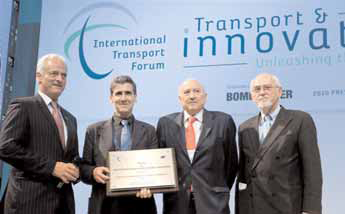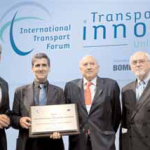The award was granted by the International Transport Forum
(ITF) and the International Association for Public Transport (UITP) at the International Transport Forum in Leipzig 27 May 2010 in the presence of the Ministers of Transport and high-level representatives of industry and research.
The objective of the ITF 2010 Award was to acknowledge innovative public transport projects or initiatives that specifically address quality of service, sustainability of the public transport system, intermodal interfaces between public transport and other modes to achieve a seamless journey, and collaboration and leadership for innovation
within the public transport sector. 26 appplications of remarkable high quality were in competition.

ITF explained the selection of CRTM with the following
comments:
“Transport interchange stations are a crucial part of the public transport system, which allows travelers to make a wide range of trips both comfortably and pleasantly. It is more and more evident that modal integration plays a fundamental role in the transport system success. The fact that more citizens have abandoned private transport to use these interchange nodes serves as proof that the old concept of railway and public bus stations is no longer valid in today’s world.
Madrid Interchanges Plan is the culmination of this unification process between the interchange points of the intercity bus lines and the Circular Metro line. With the adequate construction and improvement of the new transport interchange stations a modalinterchange network has been organized around Madrid’s entrances in relation to the highways that access to the city and the circular
underground Metro line. Madrid Region has seven important
highways that connect the region with Madrid City. In each entrance an interchange station has been built up connected with the Metro underground network and the metropolitan and urban bus lines.
In any case it is an extremely ambitious plan, nothing like it exists in no city in the world. Other cities have been able to build one interchange station, but none has built a network of interchange stations that can move more than a million users a day and contain the entire flow of passengers accessing the city from all its entries.
Madrid Transport Interchange stations are an example of
innovation and a global benchmark, being the model exposed in
most of transport conferences for broadcast. In particular about:
- New technologies: In order to guarantee the functional viability of the transport interchange stations, a system is required to supply the stations with data and information efficiently and responsively. This system should provide the users with a comfortable environment where they appreciate the safety, rapidity and integration of all the transport available, through clear, intuitive and efficient information.
- Fire protection: The design of the installations is based on a fundamental requirement: to limit the evacuation time to six minutes, sufficient time for those in the building to evacuate and be in a safe external space. This requires that the study specifically deal with all the fire safety criteria used as a basis for the development of current regulations.
- Mobility simulators: As a result of the mobility simulators studies, it was possible to verify the designs, the operational plans and the evacuation times and conditions for the transport interchange stations, making this infrastructure safer and more comfortable for passengers.
- Traffic control: Management of several thousand vehicles per day, with their stops and waiting times at different points, represents a considerable challenge in itself, on top of the challenge posed by the unique underground configuration of the traffic interchange station, itself.
- Safety plan: Safety is one of the most important pillars of any transport infrastructure, and this is particularly true of transport interchange stations, which are used on a daily basis by hundreds of thousands of passengers.”
Source: International Transport Forum press release May 2010
www.internationaltransportforum.org/2010/prizes
For more on the Madrid Interchange Plan, contact: Javier Aldecoa
www.ctm-madrid.es
